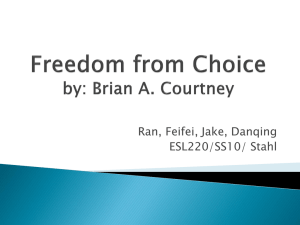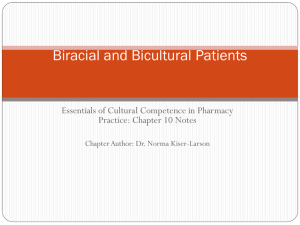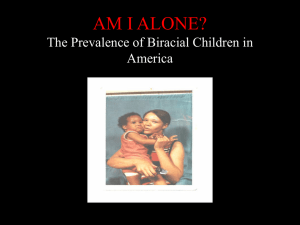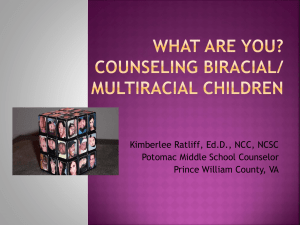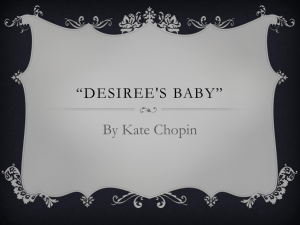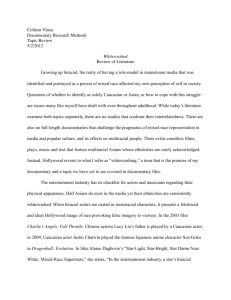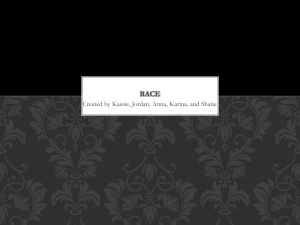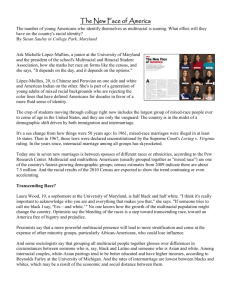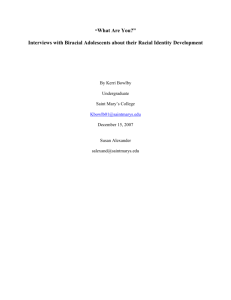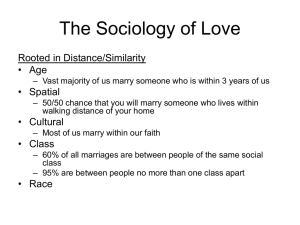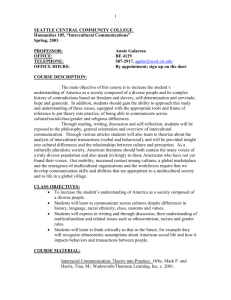Interracial Marriages
advertisement
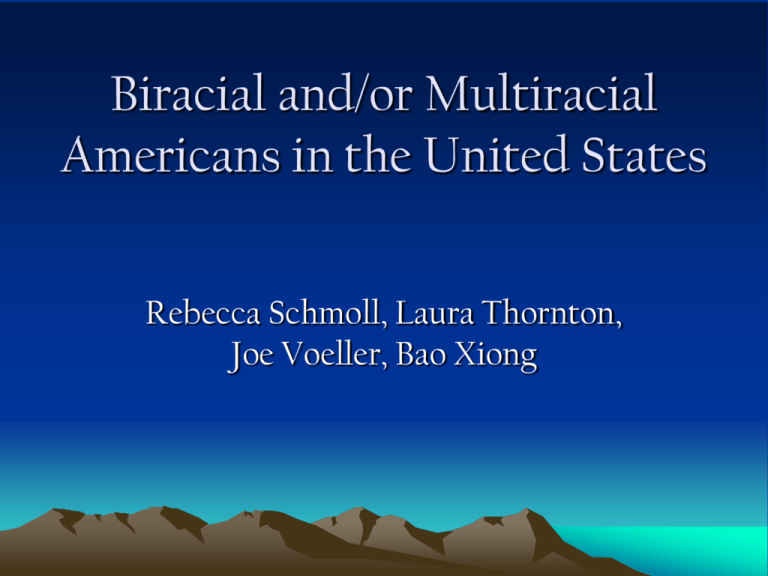
Biracial and/or Multiracial Americans in the United States Rebecca Schmoll, Laura Thornton, Joe Voeller, Bao Xiong 3. 1. 5. 2. 4. Can you Tell who is Biracial/Multiracial? 7. 8. 9. 6. 10. Movie Clip • Guess Who Interracial Marriages – Immigration laws and migrations • 1960 Anti-Asian immigration laws, Chinese-Americans • In Los Angeles, intermarriage is 5x the national average because diversity – The number of interracial marriages in the United States has increased over the years: • 150,000 couples in 1970 to 1.1 million couples in 1994 – The number of children born out of interracial marriages: • 460,300 in 1970 to 1.9 million in 1995 (Gallop Poll, 1991) KBD#5 Interracial Marriages (cont.) • Interracial marriages represented .7% of all marriages in 1970. In 1980, marriages increased to 1.3% and then to 2.2% in 1992. • However, black-white marriages still tend to be the most controversial in the public eye. • From a recent poll of 1,314 Americans of all races, it was noted that 3 in 10 people are against black-white marriage, but are more willing to accept white-Hispanic or whiteAsian marriages (Ford, 2003). • KBD#8 Racist Mammy Postcard from Early 190os wikipedia.com History of Interracial Marriages • Marriages between whites and persons of color were decried as “immoral” and “unnatural.” Polls showed that overwhelming numbers of Americans agreed. • Massachusetts forbade interracial marriage as early as 1705, a restriction which was ultimately changed in 1843 after a three year campaign in the legislature. – The legislature understood that withholding marriage based on race was an affront to human dignity and denied our basic guarantees of equality. (GLAD, 2005) KBD#8 Perez v. Sharp • 1948 California Supreme Court Case “A member of any of these races may find himself barred from marrying the person of his choice and that person to him may be irreplaceable. Human beings are bereft of worth and dignity by a doctrine that would make them as interchangeable as trains.” • The decision was controversial, courageous and correct. At that time, 38 states still forbade interracial marriage, and 6 did so by state constitutional provision (GLAD, 2005). Loving v. Virginia Richard and Mildred Loving were arrested in 1958 for violating Virginia’s 1924 Racial Integrity Act. U.S. Supreme Court struck down the remaining interracial marriage laws nation-wide. A Virginia judge had upheld that state's ban on interracial marriages, invoking God's intention to separate the races. The U.S. Supreme Court overturned his decision, declaring that: – The “freedom to marry” belongs to all Americans; – Marriage is one of our “vital personal rights” and – The right to marry is “essential to the orderly pursuit of happiness by a free [people].” KBD#5, #8 Statistics/Information • From 1960-1990 Census, white – East Asian married couples increased almost tenfold, while black – white couples quadrupled. • Reason: greater integration and the decline of white racism. • White – Asian marriages outnumber black – white marriages, yet Asian men and black women have become bitterly opposed to intermarriage. (Sailer, 1997) KBD#8 Statistics/Information (cont.) • About two percent of the population nationwide identifies itself as biracial/multiracial. • Intermarriage does not guarantee in which direction assimilation will occur because it can lean towards a dominant race. • This causes changes in society, parenting practices and young people’s way of viewing the world and themselves. Racial Demographics of U.S. • According to the 2005 CIA World Fact, an official statistics agency, America is: White – 69% Hispanics – 14.1 % or 41.3 million Black – 12.9 % or 36.4 million Asian – 4.2 % or 11.9 million Amerindian – 1.5% or 4.1 million Biracial/Multiracial – 2.4 % Wikipedia.com Online Resources • Association of MultiEthnic Americans (AMEA) http://www.ameasite.org/index.html • HAPA Issues Forum http://www.hapaissuesforum.org/ • Interracial Voice http://www.webcom.com/intvoice/ • GLAD http://www.glad.org Instructional Objectives • Multiple variables influence an individual student’s behaviors and attitudes. • These overlapping categories of identity include, but are not limited to, characteristics such as gender, race, ethnic group, social class, region of origin, religion, and level of ability. • Teachers need to be careful of first impressions and generalizations. Teaching Resource Center, U of Virginia Instructional Objectives (cont.) • Many biracial students prefer not to identify with a particular race. • Teachers need to be aware that because of the way a student looks should does not mean what we initially think. • Assuming that will rob students of their individuality. Teaching Resource Center, U of Virginia Instructional Objectives (cont.) • Do not assume that students learn in one style or another. • Recognize the different ways in which students learn. • The biracial and multiracial student population is increasing significantly, as are all groups of color. • In fact, if current trends continue, the US Census projects that groups of color will make up about 47% of the nation’s population by 2050 (Banks xxi) Teaching Resource Center, U of Virginia Instructional Objectives (cont.) • Students bring their histories into the classroom. • Some of these histories can be problematic and as educators, realizing those problems is the first step and attempting to reach out is the second. • Make students aware of every culture/race in the classroom so that students of biracial descent can feel at ease with both of their cultures Teaching Resource Center, U of Virginia What to Avoid in the Classroom • Ignoring students of color • Challenging them less often during discussion or problem-solving sessions • Counseling them to take less-advanced courses in mathematics or science • Accusing those who do well of cheating (a phenomenon also known as “spotlighting”). Teaching Resource Center, U of Virginia In the Classroom • Establish positive faculty/student relations with all of your students • Positive relationships lead to lower levels of alienation and higher retention and graduation rates • Acknowledge and address differences in the classroom and provide course material or examples that draw from a wide variety of cultures and experiences. Teaching Resource Center, U of Virginia What to realize… • Realize that vast differences exist between the various 3 cultures lumped together under such words as “ethnic,” “minority,” or “students of color.” • All African-American students, for example, do not know each other, nor do they all speak alike, think alike, or have similar life experiences. • Asian-American students may exhibit very different reactions and backgrounds than African-American students • Student behaviors or attitudes may also differ widely according to gender, social class, their specific cultural group, and even how long ago their families immigrated to the US. Teaching Resource Center, U of Virginia Social Identities Race, Class, Language, Gender Race • • • • Racial Identity Biracial/multiracial individuals are often identified with whichever race their physical features most reflect Racial Identity begins to develop during preschool years Developing a positive racial identity starts at home and in family relationships J.R. Brandell identified three methods that parents of biracial children use when confronting issues of race: 1. Deny that race is important – the child is human above all else 2. Promote only one parent’s racial identity 3. Acknowledge the child’s biracial heritage. Brandell (in Harris); Morrison; KBD #2, #3, Factors that facilitate the development of positive racial identity 1. 2. 3. 4. 5. Parents acknowledge & discuss their racial heritage with their children Children have the opportunity to develop relationships with racially diverse peers Parents are flexible in promoting the development of a positive racial identity Biracial children form positive non-stereotypical attitudes towards others Family identifies itself as an interracial unit & has social interactions in racially integrated social institutions & organizations Harris; KBD #2 Kerwin-Ponterotto Model of Biracial Identity • Stage I – Preschool up to 5 years • Stage II – Entry to School • Stage III – Pre-adolescence • Stage IV – Adolescence • Stage V – College/Young Adulthood • Stage VI – Adulthood Harris; KBD #2 Identity Problems • Identity problems arise when biracial/multiracial children feel like they have to choose one racial group over another in order to develop an identity • Inability to Identify with both parents – Disloyalty/Guilt – “When I was younger, I wanted to identify with both of my parents, but I felt like I didn’t identify with my dad because I only had white friends. I use to ask my mom, a lot, why I didn’t have any black friends and if my dad was mad at me for not having any black friends.” ~O’Neal Hampton • Biracial children can receive rejection from both sides • Biracial children may feel confusion and frustration when they have close relationships with both races outside of school, but they come to school and don’t identify with both races. – I think it is difficult for biracial kids to have a white parent, grandparent, uncle, cousin, etc. that they feel they fit in with at home, but they go to school and don’t fit in with anybody white. That was a huge problem for me.” ~O’Neal Hampton Hampton; Nitardy; Sebring (in Harris) KBD #8 Class • African American, Mexican Americans, Puerto Ricans, and American Indians have the severest economic deprivation of all ethnic groups • In 2001, the median income of… – $60,158 – Asian American and Pacific Islander families – $54,067 – White families – $34,490 – Latino Families – $33,598 – Black Families • In families with married couples… – Black married couples earn 84% of the median income of whites – Latino married couples earn 67% of the median income of whites • People of color make up a disproportionately high percentage of people in poverty. – White population – 8% – Latino population – 23% – Black population – 24% Gollnick & Chinn What does this mean for Biracial Individuals? • Persons of color may be stereotyped to be “lower class” • Because biracial individuals are generally identified with the parent of color, they will often be stereotyped into the perceived class of the person of color they are seen as. – someone who is Black & White will most often be identified as Black and will therefore often be stereotyped to be lower class – “Groups of nearly equal status allow for greater social and economic mobility” (Asian and White) • Problems with Families/Relatives Psychological; KBD #8 Colorism & Class • Whiteness or lightness valued above Blackness or darkness – Research: • Black Children select White dolls • Black men tend to prefer lighter-skinned women as intimate companions • Blacks with lighter skin tones fare better educationally and economically • Since 1960s, most Blacks appointed to prominent government positions have had light skin. – Lightness: intelligence, refinement, prosperity, femininity – Darkness: toughness, meanness, criminality, masculinity. – These are historically based meanings (Slavery) • Racist views: • Light Skin preferred to Dark Skin (by Whites) • Light Skinned person inferior to Darker Skinned Blacks (by Blacks) • A persons relative lightness or darkness determines whether he/she can access the benefits associated with a particular class (Buffer Class) Jones; KBD #4, #8 Class in the Classroom • Be aware of your own assumptions, beliefs, opinions regarding class • Be aware of comments – use the moment to discuss stereotypes, attitudes, and feelings • Be careful in talking about things that relate to money (dances, vacations, school supplies) Morrison Language 1. Communication – Mixed Languages: People that identify themselves as biracial also identify themselves with two different languages. – Ex: Someone who is Korean and American may find the English language important, and their American heritage and the Korean language important for her Korean heritage. Engelken (2005); KBD #4 Language (cont.) 2. Verbal Abuse – Names Given to biracial children: half-breed oreo, mulatto, mixed, Mesitzo, Amerasian. Harris (1997) Language (cont.) 3. Frequently Asked Questions - # 1 question: Where are you from?. *This question can often be offensive to biracial children because they are only asked this question because they look different. - Younger aged children that are biracial: “Are you black?” *It is natural for young children to ask these type of questions. Individuals that are biracial often take this offensive and “teachers need to be ready to help children respond in a way that builds their self concept and educates the questioner”. Harris (1997); Schwartz (1998); KBD #6 Language (cont.) 4. Enhanced Language Facility – Individuals who are socialized as multiracial frequently have an enhanced sense of language because of their ties to a duplicate-heritage. Schwartz (1998); KBD #4 Gender 1. Gender Confusion – Conflicts about sexuality and “What is my sex role?” *Biracial Males often feel anxiety of rejection by women *Biracial Females often perceive their future sexual partners limited to minority men. Harris (1997); KBD #12 Gender (cont.) 2. Studies A.) In a clinical study of biracial children, it proposed that the greater the child’s problem of racial identification, the greater the problem of sexual identification (Harris). B.) Kerwin Study: (interview of 9 Black/White biracial children from six different interracial families) -Girls identified primarily with their mothers -Gender seemed more important of a factor for females than males in racial identity development. -One 16 year old male identified himself primarily with his White father, even though he had little physical resemblance. Harris (1997); KBD #12 What can Educators do? 1. Reflect and Respect the preferences of individual children when alluding to their heritage. 2. Examine a student’s personal values and what is important to them. 3. Ensure that no children are victimized by others. 4. Ensure that the identity chosen by students is accepted and respected by peers 5. Help children develop the skills and confidence needed to protect themselves from and verbal or physical abuse. 6. Facilitate age-appropriate discussions and foster open and supportive questioning about race. 7. Refrain from breaking groups into specific categories defined by color or physical characteristics. 8. Overall, understand the identity process for individuals who classify as biracial or multiracial. Schwartz (1998); KBD #1, #2, #4, #6, #7, #8, #10 What Can Educators Do? (cont.) • Develop and share family trees • Provide dolls, books, posters, etc. that depict individuals with multiracial characteristics • Encourage cooperation • Curriculum that transcends ethnic boundaries • Demonstrate how people in the U.S. have successfully mixed languages, cultures, and religions throughout its history • Identify multiracial heroes • Address the history of racism • Address questions in a calm and supportive manner • Include biracial/multiracial persons as assembly and classroom speakers Morrison; Portrait; Schwartz; KBD #1, #4, #5, #6, #7, #8, #15 Things Teachers Should Not Do • Do not assume a child is Black, White, Native American, etc. based on their physical characteristics. – “People don’t realize that biracial individuals are in fact biracial. They have two different parents, are offended by black jokes and white jokes, and they want to identify with two different races.” ~O’Neal Hampton • Do not assume that a biracial child has the identity only of the parent of color. • Do not automatically attribute a child’s problems to his or her mixed heritage. Hampton; Wardle (in Nitardy); KBD #8 Minnesota Based Examples • Robert E. Willis, Motivational Speaker telesis@ix.netcom.com Minnesota Inclusiveness Program • MP Mission • MP Overview • MP Projects Minneapolis Anti-Racist Action • Fighting oppression through direct action and education. • ARA-a large network of anti-racist groups. • Minneapolis is a subset. Case Study Demographics • • • • • • • Howard Elementary School (Grades K-6) Enrollment: 500 students Students of Color: 41% (205 students) Biracial Students: 4% (20 students) Other: 55% (275 students) District Enrollment: 25,000 students City Size: 400,000 residents Case Study Mrs. Stevens has been hearing comments directed towards Trey, a student of black and white descent, and the only biracial student in her Kindergarten class. One day Mrs. Stevens notices Trey excluding himself from the group activities with the other children. He appears as if something is bothering him. Mrs. Stevens approaches him and asks him if everything is okay. Trey complains to Mrs. Stevens about not wanting to be by the other kids in the class because of the questions the students have been asking him. If you were the teacher, how would you handle the following comments? Case Study (cont.) Group 1: Why is your Mommy’s skin white if your skin is brown? Group 2: Why is your hair kinky? Group 3: Why does your skin look dirty? Group 4: Why don’t you look like everyone else? Each group should answer the following questions: A.) If you heard this comment, what would you say to answer the question and handle the situation? B.) How will you teach your students about different races so they understand? Knowledge Bases for Diversity 1. Foundations of Multicultural Education 2. Sociocultural Contexts of Human Growth and Development in Marginalized Ethnic and Racial Cultures 4. Language, Communication, and Interactional Styles of Marginalized Cultures 5. Essential Elements of Culture 6. Principles of Culturally Responsive Teaching and Culturally Responsive Curriculum Development 7. Effective Strategies for Teaching Minority Students 8. Foundations for Racism 10. Culturally Responsive Diagnosis, Measurement, and Assessment 12. Gender and Sexual Orientation 15. Foundations of International and Global Education Warring, 1992 References • • • • • • • • • • • • Engelken, L. Personal Interview. 10 Oct. 2005. GLAD, (2005). Marriage A History of Change. Retrieved December 3, 2005, from http://www.glad.org/right/OP3-historyofchang.shtml Gollnick, D. M., & Chinn P. C. (2006). Multicultural Education in a Pluralistic Society. Upper Saddle River, NJ: Pearson. Hampton, O. Personal Interview. 1 Nov. 2005. Harris, H. L. (2003). Multiracial students: What school counselors need to know. Retrieved December 5, 2005http://www.ericdigests.org/2005-2/multiracial.html Harris, H. L. (1997). Issues concerning interracial families. Retrieved November 10, 2005 from http://soeweb.syr.edu/CHS/pedersen/training/old/a9.htm Jones, T. (2000). Shades of brown: The law of skin color. Retrieved December 8, 2005 from http://www.law.duke.edu/journals/dlj/articles/dlj49p1487.htm#H2N7 Nitardy, C. (2004). Identity problems in biracial youth. Retrieved December 1, 2005, 2005 from http://education.umn.edu/EdPA/licensure/leader/2004Fall/identity.html Minneapolis Anti-Racist Action. (1997). Fighting oppression through direct action and education. Retrieved December 1, 2005 from http://www.geocities.com/CapitolHill/Lobby/2853/ Minnesota inclusiveness program. (2005). Retrieved December 1, 2005 from http://www.miprog.org/history.html Morrison, J., & Bordere, T. (2001). Supporting biracial children's identity development. Childhood Education, 77(3), 134. Retrieved December 1, 2005, from the Infotrac database. Nitardy, C. (2004). Identity problems in biracial youth. Retrieved December 1, 2005, 2005 from http://education.umn.edu/EdPA/licensure/leader/2004Fall/identity.html References (cont.) • • • • • • • • • • • Portrait of Frederick Douglass(1866). New York Historical Society. Retrieved December 8, 2005, from http://www.pbs.org.ezproxy.stthomas.edu/wgbh/aia/part4/4h2962.html Portrait of Halle Berry, Alicia Keys, and Tiger Woods. Retrieved December 1, 2005 from http://www.blackflix.com/articles/multiracial.html Portrait of Maria Tallchief. Retrieved December 1, 2005, from http://www.nativecc.com/JJ_site/tallchief_photo_portrait.html Portrait of Mammy Card Interracial.. Retrieved November 15th, from http://enwikipedia.org/wiki/Race_(U.S._Census) Portrait of Walter White. Retrieved December 1, 2005 from http://www.mixedfolks.com/images/walterwhite.jpg Psychological Services Center. (2004). Biracial identity formation. Retrieved December 5, 2005 from http://www.uc.edu/psc/sh/SH_Biracial%20Identity.htm Randall, V.R. (2005). Interracial Children and the Effects on Children., Retrieved November 10, 2005, from http://www.academic.udayton.edu/race/04needs/s98alouis.htm#ChildrenIn Sailer, S. (1997). Is Love Colorblind?. Retrieved November 10, 2005, from http://www.isteve.com/IsLoveColorblind.htm Schwartz, W. (1998). The schooling of multiracial students. 138 Retrieved November 20, 2005, from the ERIC/CUE Digest database. Teaching Resource Center. (2004). Teaching a diverse student body. Retrieved December 1, 2005 from http://trc.virginia.edu/Publications/Diversity/PDFs/Chapter 1.pdf Warring, D. F. (1992). Understanding and Applying Human Relations and Multicultural Education. Scottsdale, AZ: Leadership.
